Irish Lamb Stew is one of those timeless dishes that doesn’t try too hard but still hits every note just right. It’s humble, hearty, and packed with a slow-cooked flavor that feels like a warm hug on a cold day. Whether cooking for your family, trying to impress a dinner guest, or just wanting classic comfort food, this stew delivers on all fronts.
What makes Irish Lamb Stew stand out is its simplicity. It doesn’t need a ton of ingredients or fancy techniques. The magic happens over time, letting tender chunks of lamb mingle with earthy vegetables and rich broth until it all comes together into a bowl of pure satisfaction. If you’re new to making stews or haven’t made this one yet, don’t worry—we’ll walk through everything step by step so it turns out great the first time.
You don’t have to be Irish to love this stew, but you might feel closer to the countryside once you try it.
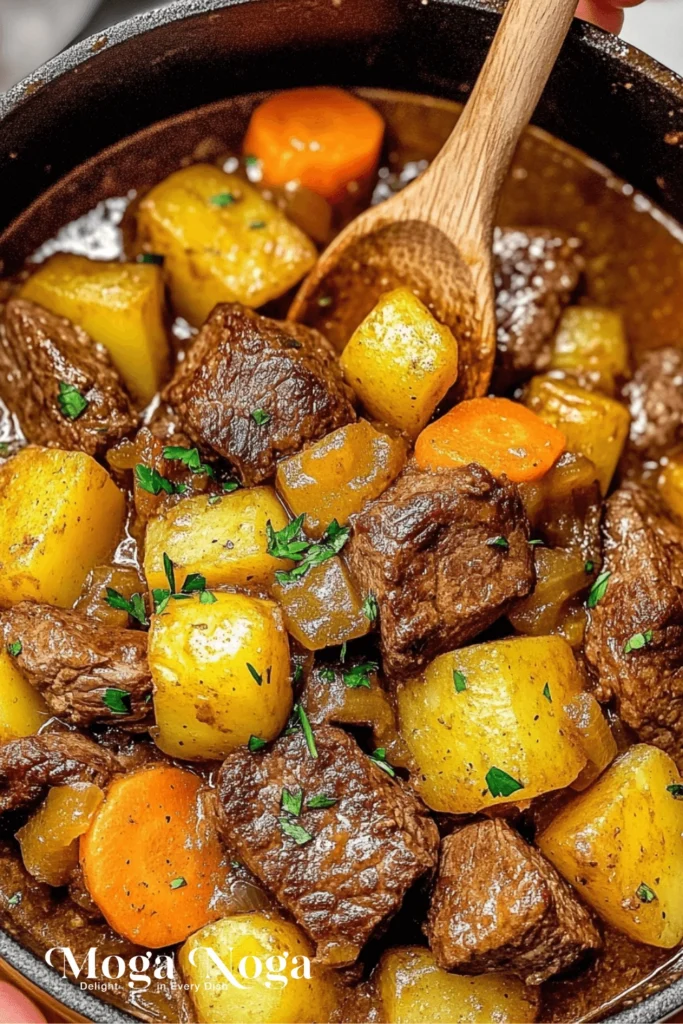
Table of Contents
Why You’ll Love This Recipe
There’s a reason Irish Lamb Stew has been around for generations—it’s simple, it’s filling, and it tastes incredible with minimal effort. Here are a few reasons this recipe might become a go-to in your kitchen:
It’s made with real, whole ingredients. There are no shortcuts or canned stuff—just good meat, fresh vegetables, and some pantry staples.
The flavor only gets better with time. Like most stews, this tastes even richer the next day, making it perfect for leftovers or meal prep.
It’s a one-pot meal. Fewer dishes, more flavor. Everything simmers together in a single pot, letting the ingredients build a deep, cozy flavor.
It’s easy to customize. While the traditional version sticks to lamb, potatoes, carrots, and onions, you can adapt it to what you have on hand without losing the soul of the dish.
Whether you serve it with a hunk of crusty bread or enjoy it as-is, Irish Lamb Stew satisfies in a way few other meals can.
Detailed Ingredients and Instructions
First, break down what you’ll need and how to make it. The beauty of Irish Lamb Stew is in its minimalism, so don’t overthink it. Stick to quality ingredients and let them shine.
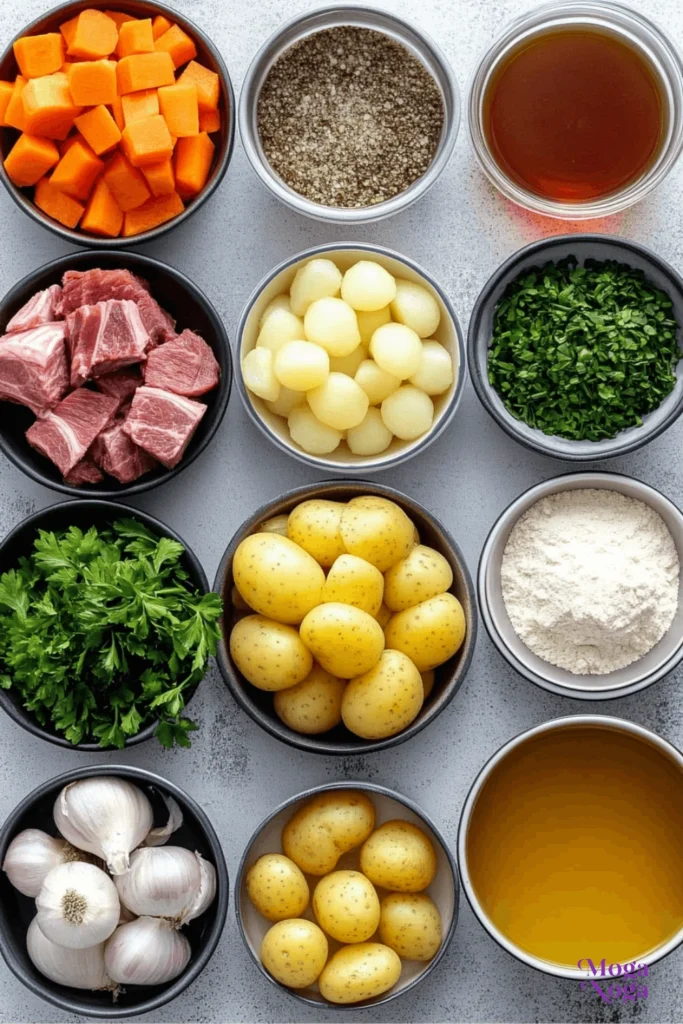
Choosing the Right Lamb
This stew is traditionally made with lamb shoulder or neck cuts full of connective tissue and marbling. That might sound like a bad thing, but it’s perfect. These cuts break down slowly over time, becoming meltingly tender and infusing the broth with rich flavor. Ask for stew meat cut from the shoulder if you’re at the butcher.
Avoid lean cuts like the leg of lamb. They tend to dry out and won’t give the same depth to the broth.
The Veggie Base
Potatoes are non-negotiable. Go for waxy varieties like Yukon Golds—they hold their shape well and soak up the broth beautifully. Carrots add sweetness and color, while onions bring the savory warmth that every good stew needs.
Some versions add leeks or parsnips; they’re great if you have them. But if you’re aiming for a true classic, keep it simple.
Step-by-Step Cooking Process
Step one is browning the lamb. This isn’t just about cooking the meat but building flavor. Searing the lamb on all sides gives you those golden-brown bits on the bottom of the pot (called fond), which add depth to the stew later. Don’t skip this step, and don’t crowd the pan. If you have a lot of meat, work in batches.
Once the lamb is browned, set it aside and sauté your onions in the same pot. If needed, add a splash of stock or water to scrape up the fond. That’s where a lot of your flavor is hiding.
Next, you’ll return the lamb to the pot and add the carrots and potatoes. Pour the stock—beef or lamb stock works best—and bring it to a simmer.
Then, it’s just a matter of letting time do the work. Cover and simmer gently for about two hours, stirring occasionally. The meat should be fall-apart tender, and the broth rich and flavorful. Near the end, you can uncover the pot to let the stew thicken if you like a heartier texture.

Tips, Variations, and Storage Options
Even though the traditional Irish Lamb Stew is a tried-and-true favorite, there’s plenty of room to tweak it based on your preferences or what’s in your fridge. Here are a few tips and variations to make the most of this dish:
Make It Your Own
Add parsnips or turnips for an extra layer of flavor. These root vegetables bring a slightly sweet and peppery taste that fits perfectly into the stew’s earthy base.
Stir in peas during the last five minutes of cooking for a pop of green and brightness.
Swap out some of the potatoes for barley. It’ll thicken the stew and add a lovely chew.
Deglaze the pot with a splash of sauce after browning the meat. It adds depth and a slightly rich, malty edge.
Make It Gluten-Free
The recipe is naturally gluten-free if you’re sticking to the basic ingredients. Just be sure your stock is certified gluten-free if needed.
Don’t Rush It
This isn’t a stew you want to rush. Low and slow is the name of the game. If you boil it too hard, the meat can seize up and turn tough. Keep the heat gentle and let the stew take its time.
Storage and Leftovers
Irish Lamb Stew stores incredibly well. It’s often better the next day. Once it’s cooled, transfer it to an airtight container and store it in the fridge for up to four days.
To reheat, warm it gently on the stove over medium-low heat. Add a splash of water or stock if it’s gotten too thick.
If you want to freeze it, go for it. Just know that potatoes can change texture after freezing—they might get a little grainy. If you plan to make a batch specifically to freeze, you could leave the potatoes out and add them fresh when you reheat.
Pro Tip: Portion out leftovers into single servings before freezing. You can pull out what you need without thawing the whole pot.
Batch Cooking and Scaling
This stew is easy to scale up for a crowd. Just be sure you’re using a big enough pot so everything cooks evenly. You should add more stock to keep the consistency right, especially if you’re doubling the recipe.
And don’t worry about being too precise. This is a rustic dish. A little more carrot or one less potato doesn’t make or break it.
Vegetarian Version
While lamb is the centerpiece of this dish, you can create a rich vegetarian version by skipping the meat and loading up on mushrooms, lentils, or chickpeas. Use a good vegetable stock and follow the same steps—browning the mushrooms, sautéing the onions, and simmering the vegetables.
You won’t get the same flavor, but you’ll still have a warm, satisfyingA bowl of stew.
Equipment Needed
You don’t need a fancy setup to make Irish Lamb Stew. That’s part of the charm. However, having a few solid kitchen tools can make the process smoother and more enjoyable.
Large Dutch Oven or Heavy-Bottomed Pot: A Dutch oven is perfect for this kind of stew. It distributes heat evenly and retains it well, which helps the lamb cook slowly and evenly. Any large, heavy pot with a tight-fitting lid will work fine if you don’t have one.
Sharp Chef’s Knife: A good knife makes prepping the meat and vegetables quicker and safer. You’ll want something that can handle slicing through raw lamb and dicing potatoes and carrots.
Wooden Spoon or Silicone Spatula: You’ll need something sturdy to stir the stew and scrape up the flavorful bits from the bottom of the pot during the cooking process.
Cutting Board: Go for a big one. Having room to prep everything in one spot helps you stay organized and keeps cross-contamination risks low, especially when working with raw meat.
Measuring Cups (Optional): This recipe isn’t too fussy, but a set of measuring cups can be helpful if you want precision—especially for stock or seasoning.
That’s all you need. Minimal gear, maximum comfort.
Related Recipes
If you enjoy the cozy, slow-cooked vibes of Irish Lamb Stew, a few other dishes bring similar comfort and satisfaction.
Beef and Guinness Stew: Similar in technique but a bit richer, thanks to the stout beer. The beef takes on a deep, malty flavor and pairs beautifully with a thick slice of buttered bread.
Chicken Pot Pie: A comforting classic filled with tender chicken, vegetables, and a creamy sauce, all tucked beneath a flaky, golden pie crust. It’s rich, satisfying, and perfect for cozy weeknight dinners.
Chicken and Dumplings :A lighter option but still packed with comfort. Tender chicken, soft dumplings, and a flavorful broth—it hits all the right notes, especially in cooler months.
Mushroom Barley Stew :This stew delivers if you’re going meat-free but still want something hearty. The mushrooms give it umami depth, while the barley adds body and texture.
Root Vegetable Soup :A lighter cousin of Irish Lamb Stew, this soup uses a medley of root veggies simmered in broth. Add some cream or purée it for a smooth, velvety finish.
Each dish taps into the same idea: simple ingredients, slow cooking, and a big, comforting flavor.
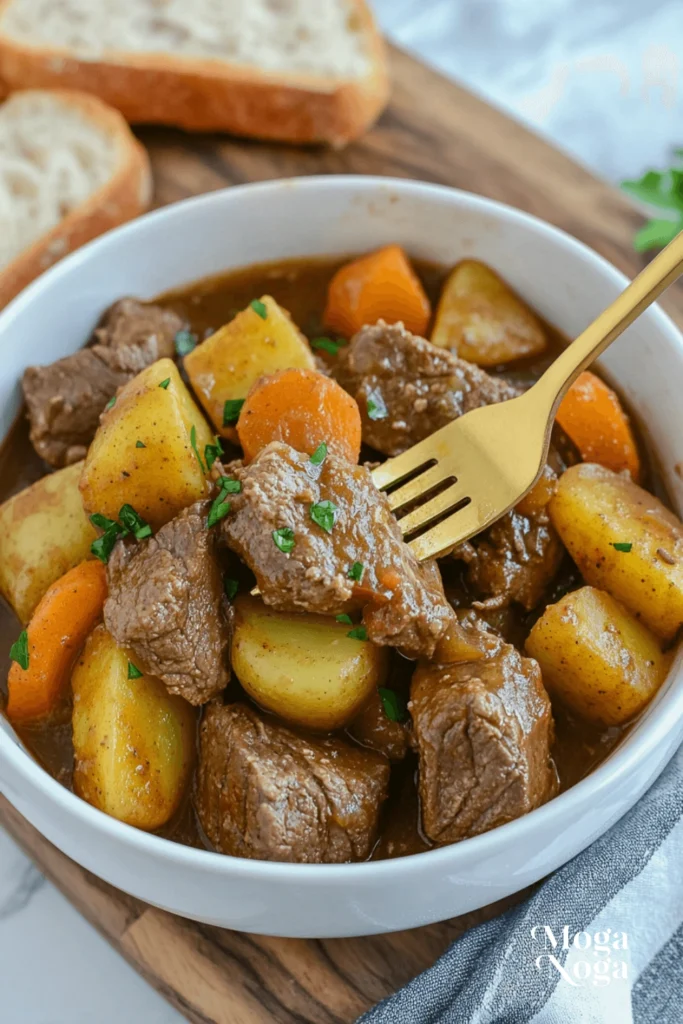
Pairing/Serving Suggestions
Irish Lamb Stew is satisfying enough to stand independently, but pairing it with the right sides, drinks, or desserts can round out your meal and elevate the whole experience.
Bread Is a Must
There’s nothing like dipping a chunk of crusty bread into the rich broth. Go with a rustic sourdough, Irish soda bread, or even a slice of rye. If you’re feeling extra, make a fresh loaf before serving—the aroma alone is worth it.
Serve It With a Simple Green Side
A basic mixed green salad with a light vinaigrette balances the richness of the stew. You don’t need anything too heavy or complicated. Even a simple side of sautéed greens like kale or spinach adds a nice contrast.
Something Sweet to Finish
If you’re serving dessert, keep it simple. Apple crumble, a slice of ginger cake, or a little bread pudding with a drizzle of cream fits the Irish vibe without overcomplicating things.
Serving Ideas for Gatherings
Irish Lamb Stew is great for feeding a crowd. Serve it in wide, shallow bowls for a rustic feel, and set out pitchers of drinks and baskets of bread. You don’t need fancy plating—it’s the meal best enjoyed casually with good company.
It also works well for meal prepping or planning. You can make the whole thing the day before and reheat it gently on the stove before guests arrive.
Frequently Asked Questions
Can I make Irish Lamb Stew in a slow cooker?
Yes, it works well in a slow cooker. Brown the lamb and sauté the onions in a pan first to lock in flavor, then transfer everything to your slow cooker. Cook on low for about eight hours or high for about four. The meat will be just as tender, and the broth develops a great depth of flavor.
What if I can’t find a lamb?
If lamb is hard to come by or not your thing, beef is the closest substitute. Use stew beef or chuck roast, and keep the rest of the recipe the same. The flavor will be a little different, but still delicious.
Can I make it ahead of time?
Absolutely. This is one of those meals that tastes even better after resting. Make it the day before, store it in the fridge, and reheat it gently. The flavors will have more time to deepen and mellow.
Is Irish Lamb Stew gluten-free?
Yes, if you stick to the core ingredients. Just double-check your stock to ensure it doesn’t contain any hidden gluten.
Can I use boneless lamb?
You can, and it’s convenient, but lamb with the bone in (like shoulder chops) often gives a richer flavor to the broth. You should bump up the herbs and seasoning slightly to compensate if you use boneless.
Nutrition Information
A standard Irish Lamb Stew (about a generous bowl) provides the following estimated nutrition values. Remember that these numbers can vary slightly depending on your exact ingredients and portion size.
Calories: Roughly between four hundred and five hundred per serving
Protein: About twenty-five to thirty grams
Carbohydrates: Around twenty to thirty grams, mostly from potatoes and carrots
Fat: Roughly fifteen to twenty grams, depending on the cut of lamb and any extra fat rendered during cooking
Fiber: Three to five grams
Sodium: Varies based on your broth and salt usage—opt for low-sodium stock to control this better
It’s a satisfying, balanced meal with good protein, moderate carbs, and no need for processed ingredients.
Seasonal and Occasion Variations
One of the best things about Irish Lamb Stew is its adaptability to different times of the year or specific celebrations.
St. Patrick’s Day
This stew is a must for any St. Patrick’s Day menu. Serve it with Irish soda bread and a pint of Guinness, and finish with something festive like shamrock cookies or a little Irish whiskey for good measure.
Fall and Winter Dinners
Cold weather is the perfect excuse to make this stew often. Add extra root veggies like rutabaga, parsnip, or celery root to deepen the seasonal vibe.
Spring Version
Light it up using baby potatoes, spring carrots, and fresh herbs. Serve with a crisp salad to balance it all out.
Holiday Gatherings
Need something simple but crowd-pleasing for a holiday dinner? Irish Lamb Stew is a cozy, comforting centerpiece for informal get-togethers.
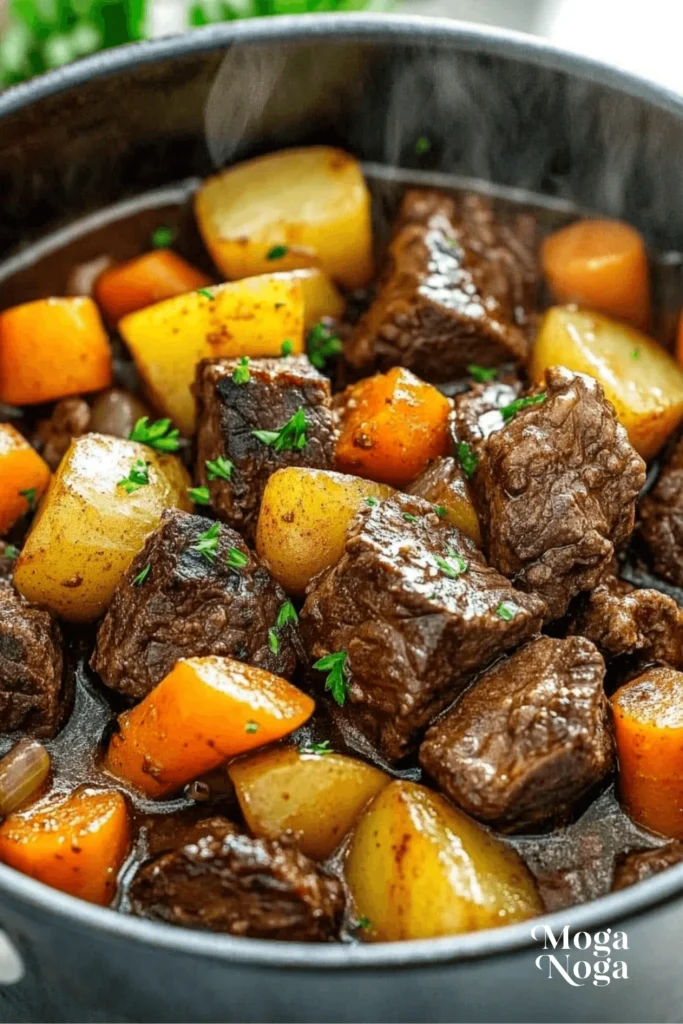
My Recipe Tips
After making Irish Lamb Stew more times than I can count, here are some key tips to make sure it turns out just right every time:
Brown the meat properly. Don’t skip this. Browning adds depth that you can’t get from boiling alone.
Use the right pot. A heavy pot or Dutch oven helps everything cook evenly and makes a big difference in texture and taste.
Don’t overcrowd your pot. When searing the lamb, do it in batches if needed. Crowding will steam the meat instead of browning it.
Cut your veggies evenly. This helps everything cook at the same pace. You want your potatoes and carrots to be fork-tender—not mushy or undercooked.
Check your seasoning at the end. The broth might taste fine initially, but you’ll usually need a final pinch of salt or a few cracks of pepper just before serving.
Conclusion
Irish Lamb Stew is more than just a recipe—it’s comfort in a bowl. It’s slow-cooked, flavorful, and adaptable, making it one of those meals that never goes out of style. Whether you’re cooking for yourself, feeding your family, or hosting friends on a chilly evening, it’s the kind of dish that brings people together.
The beauty of this stew is how low the effort is for the reward you get. A bit of chopping and browning, and then you just let it do its thing. It’s a great reminder that simple food can be deeply satisfying when made with care.
If you’ve never tried making Irish Lamb Stew at home, this is your sign to give it a shot. And if it’s already one of your favorites, it’s time to pass the recipe along to someone else. Either way, happy cooking—and enjoy every bite.
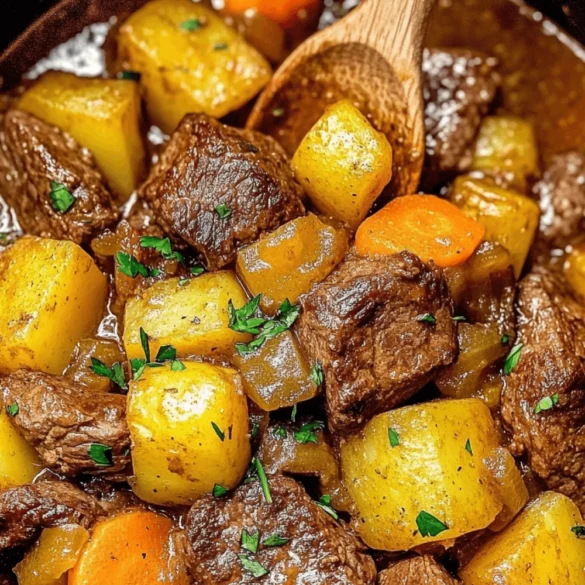
🍲 Irish Lamb Stew 🍀🥘
Ingredients
1 1/2 pounds lamb shoulder, cut into chunks
2 tablespoons olive oil
1 large onion, chopped
3 cloves garlic, minced
4 medium carrots, peeled and sliced
3 large potatoes, peeled and diced
2 cups beef broth (or lamb broth if available)
1 cup dry white wine
2 tablespoons tomato paste
1 teaspoon dried thyme
1 teaspoon dried rosemary
2 bay leaves
Salt and pepper to taste
1 tablespoon fresh parsley, chopped (optional, for garnish)
Instructions
Brown the lamb: Heat olive oil in a large pot or Dutch oven over medium-high heat. Add the lamb chunks in batches and brown them on all sides. Remove the lamb and set it aside.
Sauté the vegetables: In the same pot, add the chopped onion and garlic, cooking for 2-3 minutes until softened and fragrant. Add the carrots and potatoes, stirring to combine.
Add liquids and seasonings: Return the browned lamb to the pot. Stir in the tomato paste, followed by the beef broth, white wine, thyme, rosemary, and bay leaves. Season with salt and pepper to taste. Bring the mixture to a boil, then reduce the heat to low.
Simmer the stew: Cover the pot and let the stew simmer gently for 1 1/2 to 2 hours, or until the lamb is tender and the vegetables are cooked through. Stir occasionally, and if necessary, add a bit more broth to maintain the desired consistency.
Serve: Remove the bay leaves, and taste the stew for seasoning, adjusting salt and pepper as needed. Ladle the stew into bowls and garnish with fresh parsley if desired.

